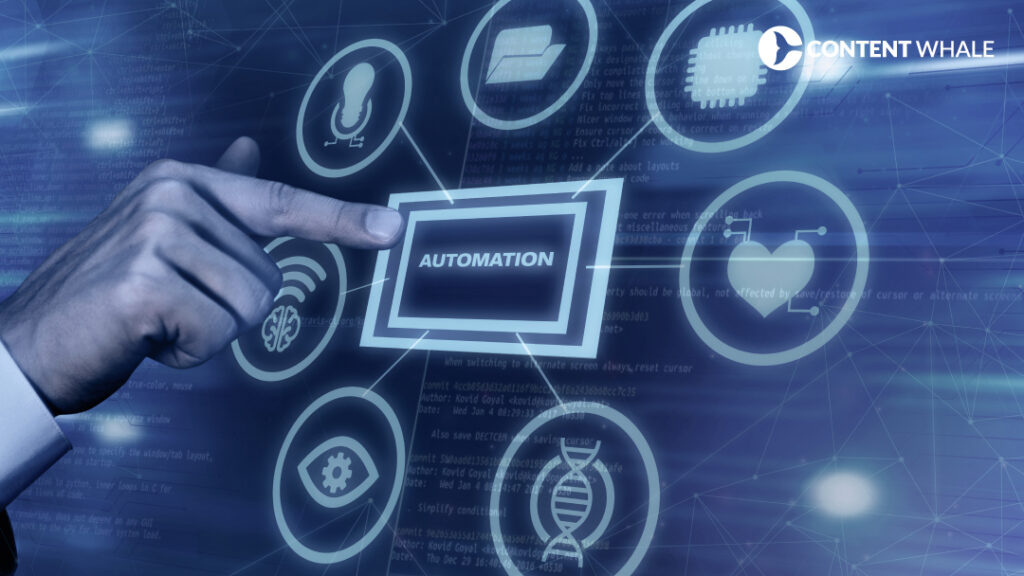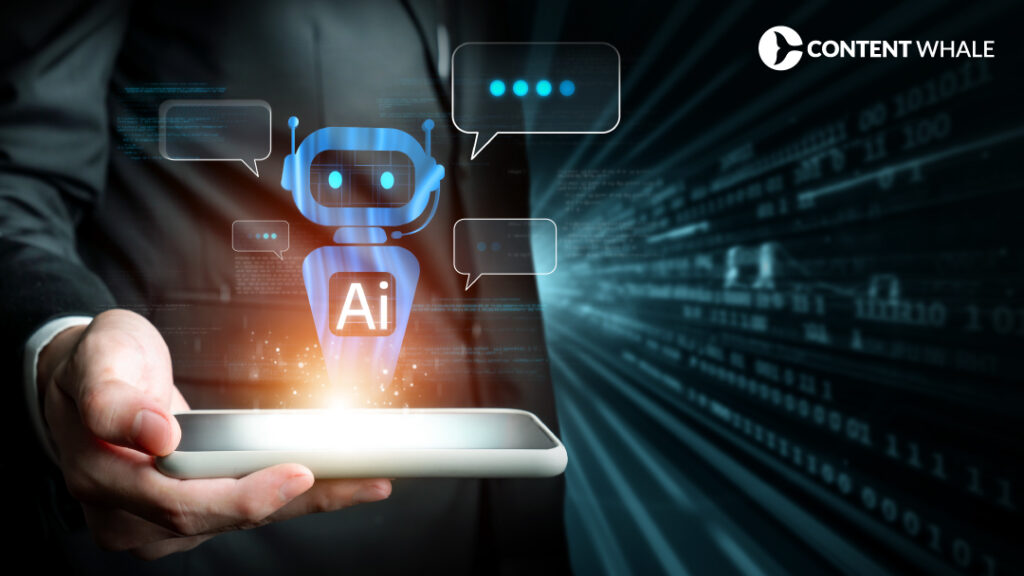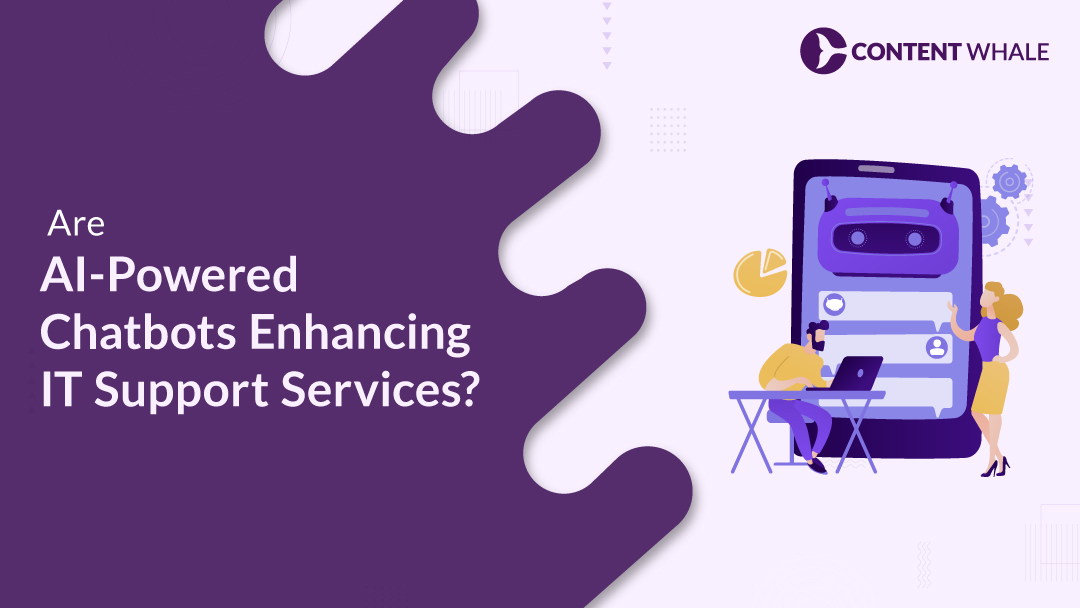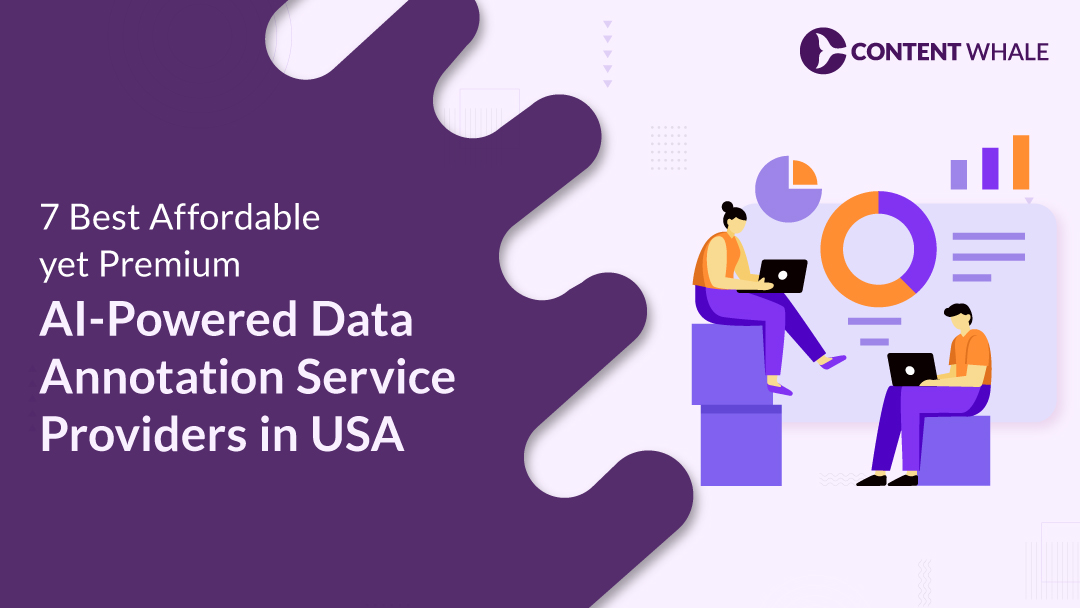AI-powered chatbots in IT support have made significant changes in how companies manage and resolve technical issues. From handling simple troubleshooting requests to offering 24/7 assistance, these it support chatbots are becoming essential for many organizations. They promise increased efficiency, reduced response times, and cost savings for businesses looking to streamline their IT operations.
However, the question remains: are these chatbots truly enhancing the customer experience, or are there limitations that hinder their full potential? With the rise of ai in it services, it’s important to explore both the strengths and challenges of this technology.
1. The Rise of AI-Powered Chatbots in IT Support
AI-powered chatbots have revolutionized how IT support systems operate, becoming indispensable in handling routine requests and improving efficiency. Here’s how they’ve risen to prominence:
A) Instant Problem Resolution
- Chatbots are now capable of resolving 68.9% of queries from start to finish.
- Tasks such as password resets, troubleshooting, and installation instructions are handled instantly, without human intervention.
B) 24/7 Availability
- One of the biggest advantages of it support chatbots is their ability to operate round the clock. They ensure users receive immediate responses, even during off-hours.
C) Cost Reduction
- By automating repetitive tasks, chatbots can help reduce operational costs by up to 30%, as businesses save on human labor.
D) Growing Adoption of AI in IT Services
- Over 60% of B2B companies now use chatbots to streamline their IT services.
- These bots can handle multiple tasks simultaneously, freeing up IT teams to focus on more complex issues.
E) Advanced Technologies like NLP & ML
- The integration of natural language processing (NLP) and machine learning (ML) has improved chatbots’ ability to understand and respond to a broader range of IT queries.
- These advancements enable virtual assistants in IT to offer more personalized and accurate solutions, further reducing the need for human intervention.
F) The Shift Toward Automation in IT Support
- Companies are increasingly turning to automation in IT support to handle ticketing, initial troubleshooting, and basic queries. This not only improves efficiency but also enhances customer satisfaction.
G) Key Takeaway:
The rise of AI-powered chatbots in IT support has made IT services more efficient, scalable, and cost-effective. As technology continues to evolve, chatbots will only become more integral to IT operations.
2. Benefits of AI Chatbots in IT Support
AI-powered chatbots have brought numerous advantages to IT support systems, transforming the way businesses handle technical queries and customer interactions. Here are the key benefits:
A) 24/7 Availability
One of the biggest benefits of AI-powered chatbots in IT support is their round-the-clock availability. Unlike human agents, chatbots never need to rest, ensuring that users can receive support at any hour. This helps businesses maintain seamless operations across time zones, ensuring that IT issues are addressed quickly, even outside of regular business hours.
B) Speed and Efficiency
Chatbots significantly reduce response times by providing instant answers to routine queries. They excel at managing tasks such as password resets, system diagnostics, and ticket creation. With the ability to handle 68.9% of queries from start to finish, it support chatbots free up human agents to focus on more complex issues, thereby improving overall efficiency.
C) Cost Reduction
By automating repetitive tasks, businesses can cut down on labor costs. Research shows that AI chatbots can help reduce operational expenses by up to 30%. They minimize the need for additional IT support staff during peak times and reduce the workload on human agents, leading to significant cost savings.
D) Scalability
Chatbots offer exceptional scalability. Whether handling a few or thousands of support tickets, they can seamlessly manage fluctuating workloads without sacrificing response quality. During high-demand periods, chatbots can maintain performance, ensuring users don’t experience delays.
E) Improved Customer Experience
With advancements in natural language processing (NLP) and machine learning (ML), chatbots can now better understand user intent, making interactions more personalized and context-aware. This contributes to a more satisfying user experience, as chatbots can provide relevant, accurate solutions quickly. Automation in IT support through chatbots also ensures that users receive consistent and reliable service, which helps boost satisfaction levels.
F) Multilingual Support
For global businesses, multilingual capabilities are essential. AI chatbots can engage with users in multiple languages, breaking down communication barriers and providing support in the user’s preferred language, further enhancing customer satisfaction.
G) Key Takeaway:
The integration of AI-powered chatbots in IT support offers significant benefits, including cost efficiency, 24/7 availability, and improved customer satisfaction. As chatbot technology continues to advance, it will play an even more critical role in delivering high-quality IT support at scale.
Table: AI-Powered Chatbots vs. Human IT Support Agents
| # | Feature | AI-Powered Chatbots | Human IT Support Agents |
| 1 | Response Time | Instantaneous, 24/7 availability | Varies based on agent availability |
| 2 | Handling Routine Tasks | Excellent at automating repetitive tasks | Time-consuming for human agents |
| 3 | Handling Complex Queries | Struggles with non-standard, nuanced issues | Capable of addressing complex technical problems |
| 4 | Emotional Intelligence | Limited empathy and emotional understanding | Can provide empathy and human touch |
| 5 | Learning and Improvement | Continuously improves through machine learning (ML) | Requires ongoing training and experience |
| 6 | Cost | Lower operational costs, especially for basic support | Higher costs, particularly for 24/7 staffing |
| 7 | Scalability | Easily scales to handle large volumes | Difficult to scale without increasing staff |
| 8 | Data Handling | Can store and process large amounts of data | More manual, limited data handling |
| 9 | Customer Satisfaction | Effective for simple queries, but limited empathy | High satisfaction for complex and emotional support |
| 10 | Escalation Capabilities | Can escalate issues to human agents seamlessly | Directly handles all issues, including escalations |
3. Limitations of AI Chatbots in IT Support
Although AI-powered chatbots in IT support offer numerous advantages, they have notable limitations. Understanding these challenges is crucial for businesses seeking to integrate chatbots effectively into their support operations. Here are some of the key limitations:
A) Struggles with Complex Issues
- Limited problem-solving capabilities: While chatbots handle simple tasks efficiently, they struggle with complex technical issues. For example, chatbots can provide assistance with basic troubleshooting, but they often fall short when dealing with multifaceted or highly specific problems.
- Ambiguity and unconventional phrasing: Chatbots can misinterpret queries if users don’t articulate them clearly or use language that falls outside the chatbot’s predefined scope.
B) Lack of Empathy
- Absence of emotional intelligence: Chatbots lack the ability to understand or respond to emotions. This makes it difficult for them to offer the level of empathy needed in stressful situations. For users facing a frustrating IT issue, an empathetic response can make a significant difference, something that it support chatbots fail to provide.
- Impersonal interactions: Unlike human agents, chatbots cannot offer personalized reassurance or emotional support, leading to customer dissatisfaction in sensitive cases.
C) Misunderstanding User Intent
- Interpretation challenges: Despite advances in natural language processing (NLP), chatbots sometimes misunderstand user intent, especially when the language is unclear or complex. This limitation can result in inaccurate or irrelevant responses, frustrating users who may already be struggling with an IT issue.
- Lack of contextual understanding: AI chatbots often rely on predefined scripts, which limit their ability to understand context or nuance, particularly in multi-step or layered issues.
D) Inefficient Escalation to Human Agents
- Handoff issues: Chatbots often need to escalate complex problems to human agents. However, this process can be inefficient if the chatbot fails to pass along detailed information, requiring the user to repeat themselves. A poor handoff can prolong issue resolution, reducing overall customer satisfaction.
- Delayed resolutions: If escalation is not seamless, users may face longer wait times before their issue reaches a human agent, negating the efficiency chatbots are supposed to bring to automation in IT support.
E) Privacy and Security Risks
- Data handling concerns: Chatbots handle sensitive customer information, which raises concerns about privacy and data security. Without robust encryption and security measures, ai helpdesk systems could expose personal or confidential data to unauthorized parties.
- Compliance issues: Businesses must ensure their chatbot systems comply with data protection laws, such as GDPR, to avoid legal complications.
4. Real-World Impact: Do Chatbots Improve IT Support Efficiency?
The implementation of AI-powered chatbots in IT support has proven to significantly enhance efficiency and productivity in various industries. By automating routine tasks, chatbots reduce the strain on human agents, streamline workflows, and improve customer satisfaction. Here are some real-world examples of their impact:
A) Improved First-Response Resolution
Companies like Bradesco, a Brazilian bank, experienced a drastic reduction in customer wait times after implementing chatbots. Their system handles over 283,000 questions a month with an impressive accuracy rate of 95%. By resolving common queries instantly, the bank decreased average wait times from 10 minutes to mere seconds. This has improved customer satisfaction and significantly lightened the load on human agents.
B) Increased Efficiency and Agent Support
A German multinational bank deployed AI-powered chatbots to handle IT support queries and saw their issue containment rate rise from 23% to 40%. This allowed their IT support team to focus on more complex issues, boosting overall productivity and reducing the number of tickets requiring human intervention. This type of automation in IT support ensures that agents can dedicate their time to critical problems rather than mundane tasks.
C) Enhanced Customer Satisfaction
In the energy sector, Stadtwerke Düren used chatbots to handle inquiries about billing and meter readings. Their chatbot, NorBot, managed to resolve 55% of customer questions without human involvement. This not only improved customer satisfaction but also allowed the company to respond promptly during peak periods, ensuring seamless customer support.
D) Cost Reduction and ROI Gains
For companies like Telenor, a telecommunications provider, chatbots exceeded expectations by boosting customer satisfaction rates by 20% and increasing revenue by 15%. The instant responses and wide integration capabilities offered by AI chatbots significantly improved their customer engagement, demonstrating the efficiency of chatbots in meeting customer demands quickly and effectively.
5. Are AI-Powered Chatbots a Threat to IT Jobs?

As AI-powered chatbots become more integrated into IT support, concerns about job displacement have surfaced. However, the impact on the job market is multifaceted, with both challenges and opportunities arising from this technological shift. Here’s a breakdown of the key considerations:
A) Automation of Routine IT Tasks
- Replacing repetitive tasks: Chatbots can efficiently handle routine, repetitive tasks such as password resets, ticketing, and basic troubleshooting. This automation reduces the need for human intervention in these areas, potentially threatening entry-level IT roles focused on such tasks.
- Freeing up human workers: While chatbots take over simpler tasks, they allow human IT professionals to focus on more complex issues that require creativity, critical thinking, and deep technical knowledge.
B) Job Evolution: New Roles in AI Development
- Emerging roles: The rise of AI has created demand for new roles such as AI specialists, data scientists, and chatbot developers. These positions require advanced knowledge in areas like machine learning and natural language processing (NLP).
- Ethical oversight and AI maintenance: As AI-driven support solutions grow, roles focusing on maintaining AI systems and ensuring ethical development (e.g., preventing bias) are becoming more critical, offering new career paths in the evolving job market.
C) Human-AI Collaboration: The Hybrid Model
- Complementary approach: Rather than replacing human agents, chatbots will assist them in handling basic IT queries while escalating more complex issues to humans. This hybrid model boosts productivity by allowing chatbots to handle simpler tasks and human agents to focus on more challenging ones.
- Improved customer experience: By combining AI’s efficiency with human problem-solving abilities, businesses can provide faster, more personalized IT support, enhancing customer satisfaction.
D) Upskilling and Reskilling for Job Security
- Focus on reskilling: As AI automates many tasks, IT professionals will need to upskill in areas such as AI system management, data analytics, and cybersecurity to stay relevant.
- Investment in learning: Companies are already focusing on reskilling their workforce to handle these shifts, ensuring that employees can adapt to the changes AI brings.
6. AI Chatbots and IT Support Automation: What the Future Holds

The future of AI-powered chatbots in IT support looks incredibly promising, with advancements in areas like natural language processing (NLP) and machine learning. These technologies are enhancing the capabilities of chatbots, allowing them to handle more complex tasks and provide a higher level of customer service. Here are some key trends shaping the future of AI chatbots in IT support:
A) Enhanced Emotional Intelligence
Future chatbots will be able to detect and respond to emotions like frustration or confusion, offering more empathetic and context-aware interactions. This is particularly important in IT support, where users often need quick solutions during stressful situations. By incorporating emotional intelligence into virtual assistants in IT, chatbots can enhance user satisfaction by delivering more personalized responses.
B) Omnichannel Support
As users interact across multiple platforms (websites, mobile apps, messaging services), chatbots will be able to offer seamless support regardless of the medium. Omnichannel chatbots will ensure users receive consistent and efficient IT support whether they are interacting through email, WhatsApp, or voice-based platforms. Companies like Amazon have already implemented such solutions, providing instant, 24/7 support across different channels.
C) AI and Human Collaboration
The future of IT support will rely heavily on a hybrid model, where AI chatbots handle routine tasks and human agents tackle more complex issues. This collaboration allows businesses to maintain operational efficiency while still providing the human touch required for more intricate problems. Companies like HubSpot and Amazon are already benefiting from such systems, where chatbots manage repetitive inquiries, and human agents handle escalations, significantly improving overall service.
D) Predictive Support
AI-driven predictive analytics will play a crucial role in preemptively identifying potential IT issues before they escalate. Chatbots will leverage historical data to predict user problems, reducing downtime and improving system reliability. This proactive approach to automation in IT support will help prevent common issues from becoming major disruptions.
7. Real-World Impact: Do Chatbots Improve IT Support Efficiency?
The implementation of AI-powered chatbots in IT support has revolutionized customer and internal support systems across industries. These tools significantly improve operational efficiency, streamline workflows, and provide round-the-clock availability. Here are some examples of their real-world impact:
A) Banking
In the banking sector, AI chatbots have made significant strides. For instance, Bank of America introduced “Erica,” an AI-powered assistant, that helps users manage their finances, make payments, and receive personalized financial advice. By automating repetitive tasks like balance inquiries and spending tracking, Erica has dramatically reduced customer wait times and improved user satisfaction. This success has encouraged other financial institutions to adopt similar systems, reducing costs and optimizing customer support.
B) E-Commerce
E-commerce platforms like Amazon and Shopify use AI chatbots to enhance customer experiences. For example, Amazon’s chatbots assist with product recommendations, order tracking, and returns management. This ensures quick resolutions to common customer queries, freeing up human agents for more complex issues. Shopify’s Sidekick chatbot helps store owners redesign their websites and manage customer queries, reducing response times and boosting sales.
C)Healthcare
Healthcare companies, such as HealthTap, use chatbots to assist patients by diagnosing symptoms, scheduling appointments, and offering healthcare advice. This has enabled healthcare providers to handle a higher volume of inquiries, offering faster responses and improving patient care outcomes.
D) Retail
Retailers like Sephora and H&M use chatbots to provide personalized shopping experiences. Sephora’s chatbot recommends products, offers virtual makeup try-ons, and provides beauty tutorials, enhancing customer engagement and increasing conversion rates. Similarly, H&M’s chatbot suggests fashion items, tracks orders, and provides size and fit guidance, reducing product returns and enhancing customer satisfaction.
E) Food & Beverage
Domino’s Pizza uses a chatbot to streamline the ordering process. Customers can place and customize their orders, track deliveries in real-time, and receive notifications about ongoing promotions. This system has simplified the user experience, making it easier for customers to place orders, which has led to increased sales and customer loyalty.
8. Are AI-Powered Chatbots a Threat to IT Jobs?
The integration of AI-powered chatbots into the workforce, especially in IT support, has stirred concerns about job displacement. However, the reality is more nuanced. While chatbots can automate repetitive tasks, they also present opportunities for workforce enhancement and skill evolution.
A) Automation of Routine Tasks
- Job displacement: Chatbots are well-suited for handling repetitive tasks such as answering FAQs, managing tickets, and conducting basic troubleshooting. This can lead to a reduction in certain entry-level roles in IT support, particularly those focused on these repetitive tasks.
- Job transformation: At the same time, this automation allows human agents to focus on more complex tasks that require critical thinking, creativity, and deep technical knowledge. This shift in responsibilities opens new avenues for human workers to take on higher-value roles within organizations.
C) Creation of New Roles
- Emerging jobs: With the rise of AI in IT services, new roles are emerging, including AI specialists, chatbot developers, and AI quality controllers. These roles require advanced skills in AI programming, data analysis, and machine learning, creating opportunities for workers willing to upskill.
- Reskilling and upskilling: As AI continues to evolve, businesses are increasingly focusing on reskilling their workforce. Employees who adapt by learning how to manage, train, and work alongside AI-driven support solutions will find themselves in higher demand. Reskilling programs are becoming essential to ensure that workers remain relevant in the evolving IT landscape.
C) Collaboration Between AI and Humans
- Hybrid models: Rather than completely replacing humans, chatbots are most effective when used in collaboration with human workers. AI can handle routine inquiries, while human agents step in for more complex or emotionally sensitive issues. This collaborative model enhances efficiency while maintaining a personal touch in IT support.
D) Mitigating the Negative Impact
- Support systems: To counteract potential job losses, governments and companies are increasingly investing in welfare programs, reskilling initiatives, and strategies to help workers transition to AI-related roles. By promoting policies that balance technological progress with human well-being, organizations can ensure that workers are not left behind.
Conclusion

In summary, AI-powered chatbots in IT support are revolutionizing the way businesses handle routine tasks, improve efficiency, and offer 24/7 service. These chatbots streamline support by tackling repetitive queries, allowing human agents to focus on more complex issues. The future holds even more promise as AI evolves, with advancements like natural language processing (NLP) and machine learning (ML) driving increasingly human-like interactions and personalized experiences.
While chatbots greatly enhance operational efficiency and reduce costs, they are not without limitations. For instance, they still struggle with complex queries that require critical thinking or emotional intelligence. This highlights the ongoing need for a hybrid model, where chatbots and human agents collaborate to deliver the best customer service.
Moreover, concerns about job displacement are being balanced by new opportunities. As chatbots take over mundane tasks, human agents can focus on more specialized roles that require creative problem-solving, ensuring that both AI and human agents work together for the future of IT support automation.
______
This blog showcases Content Whale’s expertise in creating SEO-optimized content that doesn’t just rank—it drives growth. If you’re ready to enhance your online presence, increase traffic, and achieve your business objectives, we’re ready to help. Get in touch with us today, and let’s develop content that fuels your success.
FAQs
1. What tasks can AI-powered chatbots handle in IT support?
AI chatbots in IT support excel at handling routine, repetitive tasks such as password resets, troubleshooting basic issues, and ticket management. They can also help with frequently asked questions (FAQs) and guide users through software installations or system updates. This allows human agents to focus on more complex problems.
2. How do AI chatbots impact the efficiency of IT support services?
AI chatbots improve efficiency by providing instant responses, automating repetitive tasks, and operating 24/7. This significantly reduces wait times for users and alleviates the workload for human support teams, allowing them to handle more complex or escalated issues. Companies that implement chatbots often see increased productivity and reduced costs.
3. Can chatbots replace human IT support agents entirely?
While AI-powered chatbots can handle many simple and repetitive tasks, they cannot fully replace human agents, especially when dealing with complex or emotionally sensitive issues. Human agents are still needed for higher-level problem-solving, creative thinking, and empathetic customer support. The future of IT support is likely to involve a hybrid model, where chatbots and human agents work together for optimal efficiency.
4. What are the key limitations of AI chatbots in IT helpdesks?
AI chatbots can struggle with more complex queries, especially those requiring nuanced understanding or creativity. They also lack emotional intelligence, which can be crucial when dealing with frustrated or confused users. Additionally, chatbots might misinterpret certain language or context, leading to incorrect responses. When these limitations arise, the chatbots must escalate the issue to a human agent for resolution.
5. How do AI chatbots learn and improve their performance over time?
AI chatbots improve through machine learning (ML), where they learn from previous interactions and continuously update their responses. Over time, they become more effective at understanding user queries and providing accurate solutions. Additionally, with natural language processing (NLP), chatbots get better at interpreting user intent, making their interactions more efficient and human-like.





